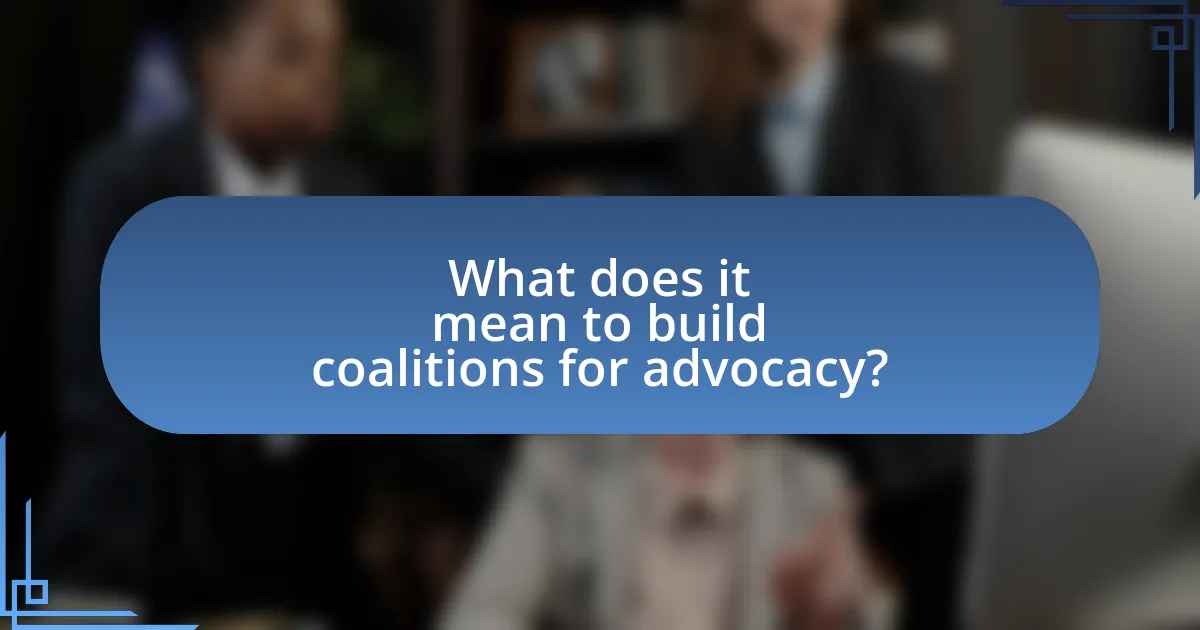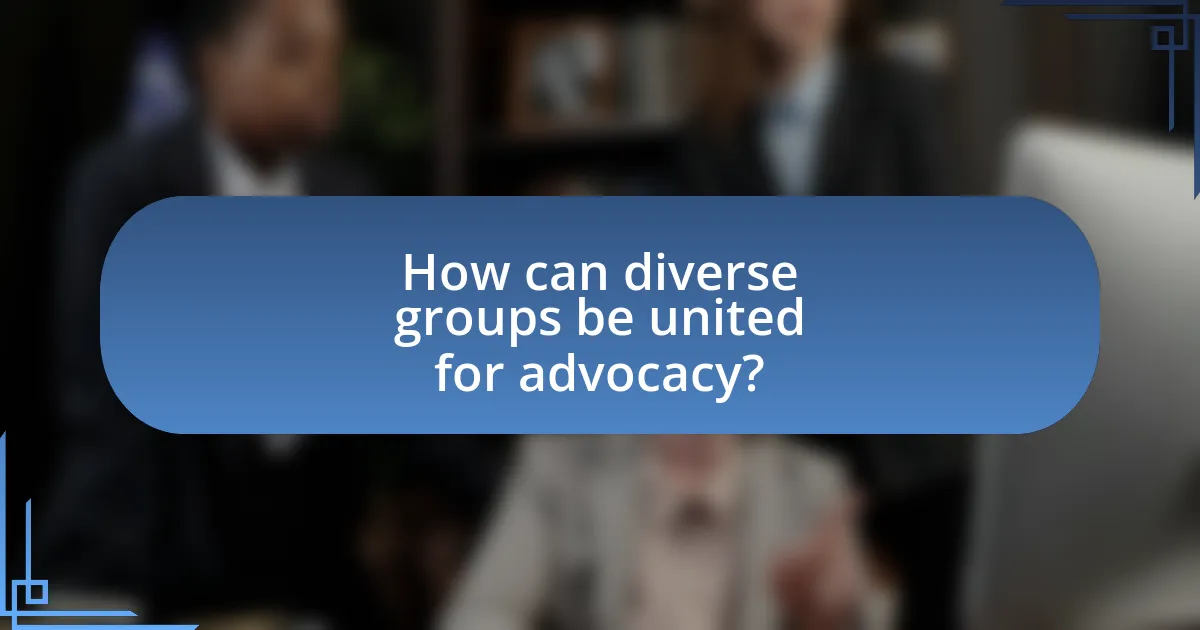Building coalitions for advocacy involves forming alliances among diverse groups to collectively influence policy or social change. This article outlines the distinct characteristics of coalitions compared to other collaborations, emphasizing the importance of shared goals, strong leadership, and diversity in membership. It discusses strategies for uniting diverse groups, the role of coalitions in amplifying marginalized voices, and the challenges faced in coalition dynamics. Additionally, it highlights best practices for sustaining coalitions over time, measuring their impact, and navigating power dynamics, while providing resources to support coalition-building initiatives.

What does it mean to build coalitions for advocacy?
Building coalitions for advocacy means forming alliances among diverse groups to collectively influence policy or social change. This process involves identifying common goals, leveraging the strengths of each group, and coordinating efforts to amplify their voices. Research shows that coalitions can enhance advocacy effectiveness by pooling resources, sharing expertise, and increasing visibility, which ultimately leads to greater impact on decision-makers and public opinion.
How do coalitions differ from other forms of collaboration?
Coalitions differ from other forms of collaboration primarily in their structure and purpose, as they are typically formed by independent organizations or groups that unite for a specific advocacy goal while maintaining their individual identities. Unlike partnerships or alliances that may involve deeper integration or shared resources, coalitions focus on collective action to influence policy or social change without merging their operations. For instance, coalitions often bring together diverse stakeholders, such as non-profits, community organizations, and governmental entities, to address complex issues like public health or environmental protection, leveraging their unique strengths while preserving autonomy. This distinct characteristic allows coalitions to mobilize a broader range of resources and perspectives, enhancing their effectiveness in advocacy efforts.
What are the key characteristics of effective coalitions?
Effective coalitions are characterized by shared goals, strong leadership, diverse membership, clear communication, and mutual trust. Shared goals ensure that all members are aligned in their objectives, which enhances collaboration. Strong leadership provides direction and motivates members to engage actively. Diverse membership brings various perspectives and resources, enriching the coalition’s capacity to address complex issues. Clear communication facilitates transparency and understanding among members, while mutual trust fosters a supportive environment that encourages participation and commitment. These characteristics are essential for the coalition’s success in advocacy efforts.
Why is diversity important in coalition building?
Diversity is important in coalition building because it enhances the coalition’s ability to address a wider range of issues and perspectives. By incorporating individuals from various backgrounds, experiences, and viewpoints, coalitions can develop more comprehensive strategies that resonate with a broader audience. Research indicates that diverse teams are more innovative and effective in problem-solving, as they bring different ideas and solutions to the table. For instance, a study by McKinsey & Company found that organizations with higher diversity levels are 35% more likely to outperform their less diverse counterparts in terms of financial returns. This evidence underscores the critical role diversity plays in creating robust coalitions capable of advocating effectively for diverse communities.
What are the primary goals of building coalitions?
The primary goals of building coalitions are to unite diverse groups for collective action, enhance advocacy efforts, and increase resource sharing. By collaborating, coalitions can amplify their voices, influence policy changes, and address complex social issues more effectively. Research indicates that coalitions can lead to improved outcomes in advocacy campaigns, as seen in the work of the National Network of Abortion Funds, which successfully mobilized various organizations to support reproductive rights through a unified approach.
How can coalitions amplify the voices of marginalized groups?
Coalitions can amplify the voices of marginalized groups by providing a unified platform that enhances visibility and influence. By bringing together diverse organizations and individuals, coalitions create a stronger collective presence that can advocate for shared goals, thereby increasing the likelihood of being heard by policymakers and the public. For instance, the Women’s March in 2017 united various feminist and social justice organizations, significantly raising awareness about women’s rights and issues affecting marginalized communities. This collective action not only mobilized thousands but also garnered media attention, illustrating how coalitions can effectively elevate the concerns of underrepresented groups.
What role do coalitions play in influencing policy change?
Coalitions play a critical role in influencing policy change by uniting diverse groups to amplify their collective voice and leverage resources. By collaborating, coalitions can present a unified front that enhances their credibility and increases their ability to engage policymakers effectively. For instance, the 2017 Women’s March coalition successfully mobilized millions across the globe, demonstrating the power of collective action in advocating for women’s rights and influencing legislative agendas. This collaborative approach not only broadens the base of support but also allows for the sharing of expertise and strategies, making policy advocacy more impactful.

How can diverse groups be united for advocacy?
Diverse groups can be united for advocacy by establishing common goals and fostering open communication. When organizations identify shared objectives, they create a foundation for collaboration, which is essential for effective advocacy. Research indicates that coalitions with clearly defined goals are more successful; for instance, a study by the National Council of Nonprofits found that 70% of coalitions achieved their objectives when they focused on mutual interests. Additionally, promoting inclusivity and respect for different perspectives enhances trust and engagement among group members, further solidifying their commitment to collective advocacy efforts.
What strategies are effective in bringing diverse groups together?
Effective strategies for bringing diverse groups together include fostering open communication, establishing common goals, and promoting inclusivity. Open communication allows individuals from different backgrounds to share their perspectives and experiences, which builds trust and understanding. Establishing common goals aligns the interests of diverse groups, creating a shared purpose that encourages collaboration. Promoting inclusivity ensures that all voices are heard and valued, which enhances participation and commitment. Research by the American Psychological Association indicates that inclusive practices lead to improved group cohesion and effectiveness, demonstrating the importance of these strategies in coalition-building efforts.
How can shared values and goals be identified among diverse groups?
Shared values and goals among diverse groups can be identified through structured dialogue and collaborative activities. Engaging participants in facilitated discussions allows individuals to express their perspectives and priorities, revealing commonalities. Research indicates that when diverse groups participate in workshops focused on values clarification, they can uncover overlapping interests and objectives, fostering a sense of unity. For instance, a study by the National Civic League highlights that community engagement initiatives that prioritize inclusive dialogue lead to stronger coalitions and shared goals.
What communication techniques foster collaboration among diverse stakeholders?
Effective communication techniques that foster collaboration among diverse stakeholders include active listening, inclusive dialogue, and the use of visual aids. Active listening ensures that all voices are heard, which builds trust and encourages participation. Inclusive dialogue promotes an environment where stakeholders feel valued and respected, facilitating open exchanges of ideas. The use of visual aids, such as charts and infographics, helps to clarify complex information and makes it accessible to all participants, regardless of their background. These techniques have been shown to enhance understanding and cooperation, ultimately leading to more effective coalition-building in advocacy efforts.
What challenges might arise when uniting diverse groups?
Challenges that might arise when uniting diverse groups include communication barriers, differing values, and power dynamics. Communication barriers can stem from language differences or varying cultural norms, which hinder effective dialogue and understanding. Differing values may lead to conflicts over priorities and goals, as groups may have distinct beliefs and motivations that complicate consensus-building. Power dynamics can create imbalances, where certain groups dominate discussions or decision-making processes, leading to feelings of marginalization among others. These challenges are supported by research indicating that diverse coalitions often struggle with these issues, impacting their overall effectiveness in advocacy efforts.
How can cultural differences impact coalition dynamics?
Cultural differences can significantly impact coalition dynamics by influencing communication styles, decision-making processes, and conflict resolution strategies among group members. For instance, cultures that prioritize collectivism may emphasize group consensus, while individualistic cultures may encourage assertiveness and personal expression. This divergence can lead to misunderstandings or conflicts if not managed effectively. Research by Hofstede (1980) highlights how cultural dimensions, such as power distance and uncertainty avoidance, shape group interactions and expectations. Consequently, recognizing and addressing these cultural differences is essential for fostering effective collaboration and achieving coalition goals.
What strategies can mitigate conflicts within coalitions?
Effective strategies to mitigate conflicts within coalitions include fostering open communication, establishing clear roles and responsibilities, and promoting shared goals. Open communication allows coalition members to express concerns and perspectives, reducing misunderstandings. Establishing clear roles and responsibilities helps to delineate tasks and expectations, minimizing overlap and potential friction. Promoting shared goals aligns the coalition’s efforts and reinforces collaboration, as evidenced by research indicating that coalitions with a unified vision experience fewer conflicts and greater success in achieving objectives.

What are the best practices for sustaining coalitions over time?
The best practices for sustaining coalitions over time include establishing clear goals, fostering open communication, and ensuring equitable participation among members. Clear goals provide a shared vision that aligns the coalition’s efforts, while open communication facilitates trust and collaboration. Equitable participation ensures that all voices are heard, which strengthens commitment and engagement. Research indicates that coalitions with defined objectives and inclusive practices are more likely to endure, as evidenced by studies showing that successful coalitions often have structured processes for decision-making and conflict resolution, leading to increased resilience and adaptability over time.
How can coalitions maintain engagement among members?
Coalitions can maintain engagement among members by fostering open communication and providing regular opportunities for collaboration. Effective communication ensures that all members feel informed and valued, which is crucial for sustaining interest and participation. Regular collaborative activities, such as workshops or joint projects, create a sense of shared purpose and strengthen relationships among members. Research indicates that coalitions with structured communication strategies and collaborative frameworks experience higher levels of member satisfaction and retention, as evidenced by a study published in the Journal of Community Psychology, which found that active engagement practices significantly enhance coalition effectiveness.
What role does leadership play in sustaining coalition efforts?
Leadership is crucial in sustaining coalition efforts as it provides direction, fosters collaboration, and maintains motivation among diverse groups. Effective leaders establish a shared vision and clear goals, which align the interests of coalition members, thereby enhancing commitment. Research indicates that strong leadership can improve communication and trust within coalitions, leading to increased effectiveness in advocacy efforts. For instance, a study by the National Council of Nonprofits highlights that coalitions with engaged leaders are more likely to achieve their objectives and sustain long-term partnerships.
How can coalitions measure their impact and success?
Coalitions can measure their impact and success through a combination of quantitative and qualitative metrics. Quantitative metrics include tracking changes in policy, funding levels, or community engagement statistics before and after coalition initiatives. For example, a coalition advocating for environmental policy may measure success by the number of new regulations enacted or the percentage increase in community participation in sustainability programs. Qualitative metrics involve gathering feedback from stakeholders, assessing changes in public perception, and evaluating the coalition’s ability to mobilize resources and support. Research indicates that coalitions that utilize both types of metrics can provide a comprehensive view of their effectiveness, as demonstrated in studies such as “Evaluating the Impact of Coalitions” by the Community Tool Box, which highlights the importance of both data-driven and narrative-based assessments in understanding coalition success.
What practical tips can enhance coalition-building efforts?
To enhance coalition-building efforts, establish clear goals and shared values among participants. This clarity fosters alignment and commitment, which are essential for effective collaboration. Research indicates that coalitions with defined objectives are 30% more likely to achieve their desired outcomes, as they provide a framework for decision-making and accountability. Additionally, fostering open communication and trust among members strengthens relationships, enabling diverse groups to work together more effectively. Studies show that trust-building activities can increase coalition engagement by up to 50%, leading to more productive partnerships.
How can coalition leaders effectively navigate power dynamics?
Coalition leaders can effectively navigate power dynamics by fostering open communication and establishing clear roles within the coalition. Open communication allows leaders to understand the interests and motivations of different stakeholders, which is essential for addressing conflicts and building trust. Establishing clear roles helps to delineate responsibilities, reducing ambiguity and potential power struggles. Research indicates that coalitions with defined leadership structures and transparent decision-making processes are more successful in achieving their goals, as evidenced by the findings in “Coalition Building: A Guide for Community Leaders” by the National Network of Partnership Schools, which highlights the importance of clarity in roles for effective collaboration.
What resources are available to support coalition-building initiatives?
Resources available to support coalition-building initiatives include funding opportunities, training programs, and networking platforms. Funding opportunities can be accessed through grants from foundations such as the Robert Wood Johnson Foundation, which supports health-related coalitions, and the Ford Foundation, which funds social justice initiatives. Training programs, like those offered by the National Coalition Building Institute, provide skills in conflict resolution and collaboration. Networking platforms, such as the Coalition for Health Funding, facilitate connections among diverse groups to share best practices and resources. These resources collectively enhance the capacity of coalitions to effectively advocate for their causes.


